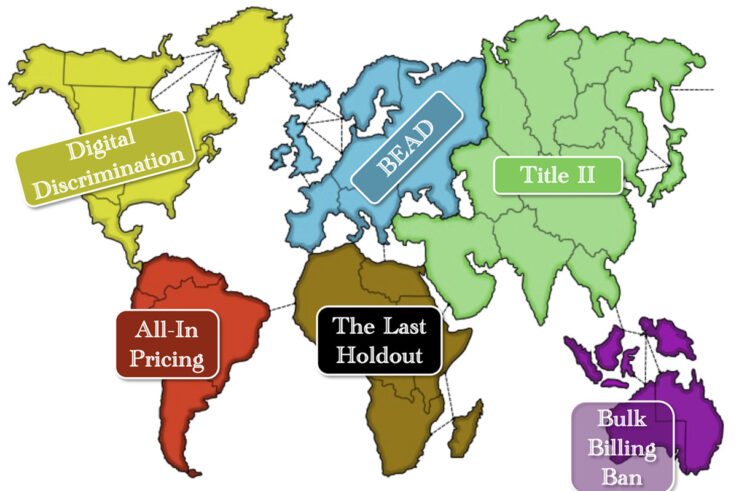
In current discussions of technology markets, few words are heard more often than “platform.” Initial public offering (IPO) prospectuses use “platform” to describe a service that is bound to dominate a digital market. Antitrust regulators use “platform” to describe a service that dominates a digital market or threatens to do so. In either case, “platform” denotes power over price. For investors, that implies exceptional profits; for regulators, that implies competitive harm.
Conventional wisdom holds that platforms enjoy high market shares, protected by high barriers to entry, which yield high returns. This simple logic drives the market’s attribution of dramatically high valuations to dramatically unprofitable businesses and regulators’ eagerness to intervene in digital platform markets characterized by declining prices, increased convenience, and expanded variety, often at zero out-of-pocket cost. In both cases, “burning cash” today is understood as the path to market dominance and the ability to extract a premium from consumers in the future.
This logic is usually wrong.
The Overlooked Basics of Platform Economics
To appreciate this perhaps surprising point, it is necessary to go back to the increasingly overlooked basics of platform economics. A platform can refer to any service that matches two complementary populations. A search engine matches advertisers with consumers, an online music service matches performers and labels with listeners, and a food-delivery service matches restaurants with home diners. A platform benefits everyone by facilitating transactions that otherwise might never have occurred.
A platform’s economic value derives from its ability to lower transaction costs by funneling a multitude of individual transactions into a single convenient hub. In pursuit of minimum costs and maximum gains, users on one side of the platform will tend to favor the most popular platforms that offer the largest number of users on the other side of the platform. (There are partial exceptions to this rule when users value being matched with certain typesof other users, rather than just with more users.) These “network effects” mean that any successful platform market will always converge toward a handful of winners. This positive feedback effect drives investors’ exuberance and regulators’ concerns.
There is a critical point, however, that often seems to be overlooked.
Market share only translates into market power to the extent the incumbent is protected against entry within some reasonable time horizon. If Warren Buffett’s moat requirement is not met, market share is immaterial. If XYZ.com owns 100% of the online pet food delivery market but entry costs are asymptotic, then market power is negligible. There is another important limiting principle. In platform markets, the depth of the moat depends not only on competitors’ costs to enter the market, but users’ costs in switching from one platform to another or alternating between multiple platforms. If users can easily hop across platforms, then market share cannot confer market power given the continuous threat of user defection. Put differently: churn limits power over price.
Contrary to natural intuitions, this is why a platform market consisting of only a few leaders can still be intensely competitive, keeping prices low (down to and including $0) even if the number of competitors is low. It is often asserted, however, that users are typically locked into the dominant platform and therefore face high switching costs, which therefore implicitly satisfies the moat requirement. If that is true, then the “high churn” scenario is a theoretical curiosity and a leading platform’s high market share would be a reliable signal of market power. In fact, this common assumption likely describes the atypical case.
AWS and the Cloud Data-Storage Market
This point can be illustrated by considering the cloud data-storage market. This would appear to be an easy case where high switching costs (due to the difficulty in shifting data among storage providers) insulate the market leader against entry threats. Yet the real world does not conform to these expectations.
While Amazon Web Services pioneered the $100 billion-plus market and is still the clear market leader, it now faces vigorous competition from Microsoft Azure, Google Cloud, and other data-storage or other cloud-related services. This may reflect the fact that the data storage market is far from saturated, so new users are up for grabs and existing customers can mitigate lock-in by diversifying across multiple storage providers. Or it may reflect the fact that the market’s structure is fluid as a function of technological changes, enabling entry at formerly bundled portions of the cloud data-services package. While it is not always technologically feasible, the cloud storage market suggests that users’ resistance to platform capture can represent a competitive opportunity for entrants to challenge dominant vendors on price, quality, and innovation parameters.
The Surprising Instability of Platform Dominance
The instability of leadership positions in the cloud storage market is not exceptional.
Consider a handful of once-powerful platforms that were rapidly dethroned once challenged by a more efficient or innovative rival: Yahoo and Alta Vista in the search-engine market (displaced by Google); Netscape in the browser market (displaced by Microsoft’s Internet Explorer, then displaced by Google Chrome); Nokia and then BlackBerry in the mobile wireless-device market (displaced by Apple and Samsung); and Friendster in the social-networking market (displaced by Myspace, then displaced by Facebook). AOL was once thought to be indomitable; now it is mostly referenced as a vintage email address. The list could go on.
Overestimating platform dominance—or more precisely, assuming platform dominance without close factual inquiry—matters because it promotes overestimates of market power. That, in turn, cultivates both market and regulatory bubbles: investors inflate stock valuations while regulators inflate the risk of competitive harm.
DoorDash and the Food-Delivery Services Market
Consider the DoorDash IPO that launched in early December 2020. The market’s current approximately $50 billion valuation of a business that has been almost consistently unprofitable implicitly assumes that DoorDash will maintain and expand its position as the largest U.S. food-delivery platform, which will then yield power over price and exceptional returns for investors.
There are reasons to be skeptical. Even where DoorDash captures and holds a dominant market share in certain metropolitan areas, it still faces actual and potential competition from other food-delivery services, in-house delivery services (especially by well-resourced national chains), and grocery and other delivery services already offered by regional and national providers. There is already evidence of these expected responses to DoorDash’s perceived high delivery fees, a classic illustration of the disciplinary effect of competitive forces on the pricing choices of an apparently dominant market leader. These “supply-side” constraints imposed by competitors are compounded by “demand-side” constraints imposed by customers. Home diners incur no more than minimal costs when swiping across food-delivery icons on a smartphone interface, casting doubt that high market share is likely to translate in this context into market power.
Deliveroo and the Costs of Regulatory Autopilot
Just as the stock market can suffer from delusions of platform grandeur, so too some competition regulators appear to have fallen prey to the same malady.
A vivid illustration is provided by the 2019 decision by the Competition Markets Authority (CMA), the British competition regulator, to challenge Amazon’s purchase of a 16% stake in Deliveroo, one of three major competitors in the British food-delivery services market. This intervention provides perhaps the clearest illustration of policy action based on a reflexive assumption of market power, even in the face of little to no indication that the predicate conditions for that assumption could plausibly be satisfied.
Far from being a dominant platform, Deliveroo was (and is) a money-losing venture lagging behind money-losing Just Eat (now Just Eat Takeaway) and Uber Eats in the U.K. food-delivery services market. Even Amazon had previously closed its own food-delivery service in the U.K. due to lack of profitability. Despite Deliveroo’s distressed economic circumstances and the implausibility of any market power arising from Amazon’s investment, the CMA nonetheless elected to pursue the fullest level of investigation. While the transaction was ultimately approved in August 2020, this intervention imposed a 15-month delay and associated costs in connection with an investment that almost certainly bolstered competition in a concentrated market by funding a firm reportedly at risk of insolvency. This is the equivalent of a competition regulator driving in reverse.
Concluding Thoughts
There seems to be an increasingly common assumption in commentary by the press, policymakers, and even some scholars that apparently dominant platforms usually face little competition and can set, at will, the terms of exchange. For investors, this is a reason to buy; for regulators, this is a reason to intervene. This assumption is sometimes realized, and, in that case, antitrust intervention is appropriate whenever there is reasonable evidence that market power is being secured through something other than “competition on the merits.” However, several conditions must be met to support the market power assumption without which any such inquiry would be imprudent. Contrary to conventional wisdom, the economics and history of platform markets suggest that those conditions are infrequently satisfied.
Without closer scrutiny, reflexively equating market share with market power is prone to lead both investors and regulators astray.




